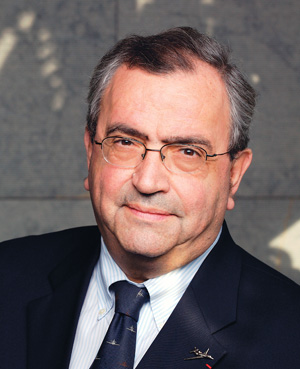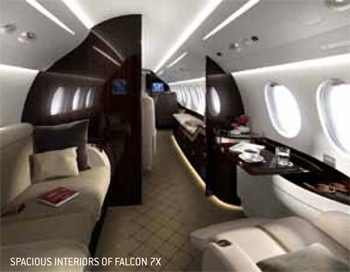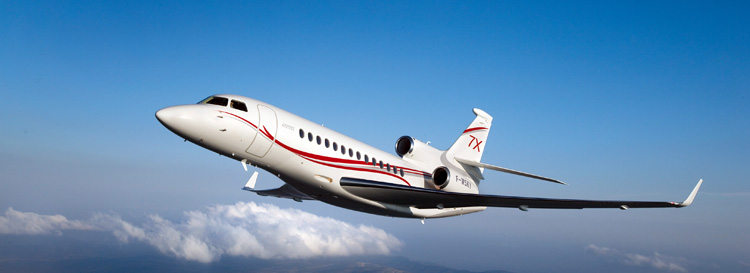- Prime Minister Narendra Modi inaugurates Aero India 2023 in Bengaluru; Releases Commemorative Stamp
- Defence Secretary meets delegations from Saudi Arabia, USA and Oman on the sidelines of Aero India 2023
- Foreign Ministers of 32 countries to attend Aero India 2023
- Embraer showcases the C-390 Millennium at Aero India 2023
‘Dassault’s Falcon 2000S is highly optimised in aerodynamic design and weight’
Interview with John Rosanvallon, President & CEO, Dassault Falcon Jet

SP’s ShowNews (SP’s): Can you please trace the history of Dassault Falcon Jet and its range of products? Are there any new models under development?
John Rosanvallon (Rosanvallon): The history of Dassault can be traced back to 1915 when founder Marcel Dassault built the famous Eclair propeller for the Spad. His vision and passion for aerospace spawned hundreds of aircraft models and over 8,000 airplanes - from fighter jets to Falcons. Marcel introduced the first Falcon in 1963 winning the praise of Charles Lindbergh and launching one of the most successful business jet programmes in history. Dassault Falcon is now the global leader in the large-cabin business jet segment having delivered over 2,100 Falcons to more than 70 countries worldwide. The family of Falcon jets currently in production includes two trijets - the Falcon 900LX and the Falcon 7X - as well as the twin-engine Falcon 2000LX and the new Falcon 2000S unveiled last year.
In addition to setting industry standards in aircraft design, parent company Dassault Aviation has also led the industry in the development of new flight systems such as the EASy Flight Deck, and the Digital Flight Control System - the first fly-by-wire control system on a business jet (for the Falcon 7X). Falcons are widely recognised for their superior performance and efficiency and are considered to be the most economical and environmentally responsible jets in their class.
The company has always invested heavily in research and product development, even during the deep recession experienced in 2008. The result of this investment will be revealed as we continue to enhance our current Falcons and prepare entirely new ones such the “SMS”, a code name for the next generation Falcon. The SMS is well into its development programme with over 1,500 engineers from our design office and our partners working together. We expect the SMS to go into service in 2016. While the aircraft is yet to be launched publicly, its key features and design goals make us optimistic that it will be enthusiastically received in the marketplace.
SP’s: What are the features of the Falcon series of executive jets that make them unique?
Rosanvallon: First of all, performance. Dassault’s design process developed through decades of experience building fighter jets gives it an advantage in everything from materials to aerodynamics. By the application of this acquired knowledge and advanced technology, our Falcons perform better. For instance, all our Falcons are robust enough to land at nearly a full take-off weight. This means they can fly multiple short hops picking up people along the way and then go on to the final destination without having to refuel. Their extremely agile field performance allows them to operate at London City Airport in the heart of the city. The 7X and the 900LX are only business jets in their category to meet the demanding requirements of this airport, with its steep approach and noise restrictions.

Another important feature gained by technology transfer is our use of advanced flight systems. The Heads Up Guidance System and the EASy Flight Deck, the most advanced ‘man-machine interface’ were both inherited from our fighter jets. The Falcon 7X is also the first (and still the only) business jet available that is equipped with a fully-digital flight control system. Incorporating such technology has greatly increased flight precision, safety and comfort.
Still another key feature welcomed by our operators is the superior fuel efficiency delivered by every Falcon. This means both lower operational costs and a lighter emissions footprint.
Dassault offers a wide range of aircraft that can meet a variety of aviation needs. Currently, Dassault Falcon has three large-series models- the 7X, the Falcon 900LX and the Falcon 2000S and 2000LX. The Falcon 7X, Dassault’s flagship business jet, features a bundle of advanced technologies. Above all, the 7X is a comfortable aircraft for passengers, featuring an exceptionally quiet and comfortable cabin and a range of 5,950 nm, which makes it capable of meeting the demands of more than 90 per cent of city trips done by the typical business aviation traveller.
The new Falcon 2000S, the latest addition to the Falcon fleet, is positioned in the super mid-size category, offering an aggressive acquisition price along with the lowest operating costs in its class. Its short field and low speed performance offer unparalleled airport access thanks to an optimised wing and all-new inboard slats. As with all Falcon business jets, the Falcon 2000S is also highly optimised in terms of aerodynamic design and weight, which also means much lower fuel consumption and the greenest footprint in its class.
SP's: Can you briefly describe the network of production and support facilities that Dassault has established to cater to its global customer base?
Rosanvallan: We’ve made a long-term commitment to all our Falcon operators for continuously improving our services. The current crisis has not changed our action plan in this regards, either. We are increasing our own maintenance capacities and extended our authorised service centers network.
The Dassault Falcon Customer Service Network currently includes more than 40 service centres and 13 spares centres strategically located worldwide, alongside access to the most advanced maintenance and communications technology, including e-maintenance and direct data broadcast, for fast and efficient technical support and assistance. Our “go teams” started some years ago as an emergency service, dispatching our technicians anywhere in the world on a moments notice. Today, that spirit of urgency has spread to become part of every aspect and anyone at Dassault worldwide. All the Dassault employees are committed to the Go Team Spirit-doing “whatever it takes” to keep our owners flying.
SP’s: What is the share of the market that Dassault Falcon Jet commands globally and who are the existing as well as emerging competitors in the regime of executive jets?
Rosanvallan: While all aircraft makers suffered during the downturn, the large cabin jet segment in which Dassault is positioned has fared better than most. Possibly it is due to the increasingly global nature of business, but our longrange large cabin jets are still on demand by many countries-especially in the BRICS. Falcon’s efficiency, versatility and resale value are timeless values for companies worldwide. This allows us to enjoy anywhere between 30 to 40 per cent of sales in what we call the high end segment. We share this market with Bombardier and Gulfstream. Dassault Falcon has always had a leadership position in Europe, Latin America and India.

SP’s: How does the company perceive the market for executive jets in the Asia-Pacific region to be in the next 20 years with specific reference to India and China?
Rosanvallan: The worldwide market for business jets seems to be recovering though more slowly than we’d like. The larger traditional markets in the US and Western Europe are still below sales levels we saw before the global economic crisis. On the other hand, we have experienced good levels of commercial activity in Russia and Latin America in 2011. The best news came from China which has been our number one market last year.
As India’s economy continues to emerge, the private sector is playing its role in developing business across the country and increasingly beyond, internationally and globally. Reaching business centres across such a large country and globally, will increasingly entail the use of private aircraft as essential business tools.
Regulation and basic infrastructure, such as local airports and FBOs, may be lagging behind the demand emerging for business aviation, but there is little doubt that business jets will add impetus to the already thriving Indian economy. Studies clearly show the positive economic impact of business aviation.
Dassault’s share of the Indian market is already strong and growing. Private investment in aviation infrastructure, supported by the Indian authorities, makes the dynamic market even more attractive. We are consolidating this position with an increase in local customer support and parts services. A network of new authorised service centres is also under consideration in addition to Air Works Mumbai which was approved last May.
More than a 20 Falcons are currently operating from airports in Bangalore, Chennai, Delhi, Hyderabad and Mumbai, and another 10 aircraft are on order for delivery to Indian customers within the next two years. We estimate the potential of a hundred new sales in the next ten years.
SP’s: What are the technological innovations and other measures being adopted by the company to address the growing environmental concerns?
Rosanvallan: The long-term growth of our industry will mostly depend on our capacity to provide efficient solutions satisfying the specific transportation needs of our customers and answering the environmental issues. Dassault is at the forefront of research and development that can be applied to improve the performance, comfort, efficiency and environmental footprint of future generations of aircraft. The company plays a key role in the Advisory Council for Aeronautical Research in Europe (ACARE), a group set up by the industry, government and academia to develop an aviation strategic research agenda for 2020; the European Union’s Clean Sky programme, which seeks to develop new technologies to reduce noxious emissions and noise on aircraft that will enter service at the beginning of the next decade. Dassault engineers are well on the way to meeting aggressive new environmental goals set under these initiatives. These include a 50 per cent reduction in carbon dioxide (CO2), an 80 per cent cut in nitrogen oxides (NOX) and a 50 per cent drop in perceived noise on the ground.





